Differentiating Wrongful and Unfair Dismissal: Employee Rights
VerifiedAdded on 2023/06/12
|5
|1180
|394
Essay
AI Summary
This essay provides a detailed comparison of wrongful and unfair dismissal from an employee's perspective. It defines wrongful dismissal as a breach of contract where an employee is dismissed without proper notice, while unfair dismissal is defined as a statutory right under the Employment Rights Act where an employee is dismissed for reasons outside the scope of five potential reasons. The essay discusses the advantages and disadvantages of each from an employee's point of view, highlighting that unfair dismissal claims typically require two years of service, while wrongful dismissal claims are based on contractual breaches. It further explores the legal recourse available to employees, including claims before the Employment Tribunal and civil actions, and emphasizes the importance of considering both employer and employee perspectives to understand the practical benefits and challenges arising from both kinds of dismissal claims. Desklib offers a wide range of resources, including solved assignments and study tools, to support students in understanding complex legal concepts.
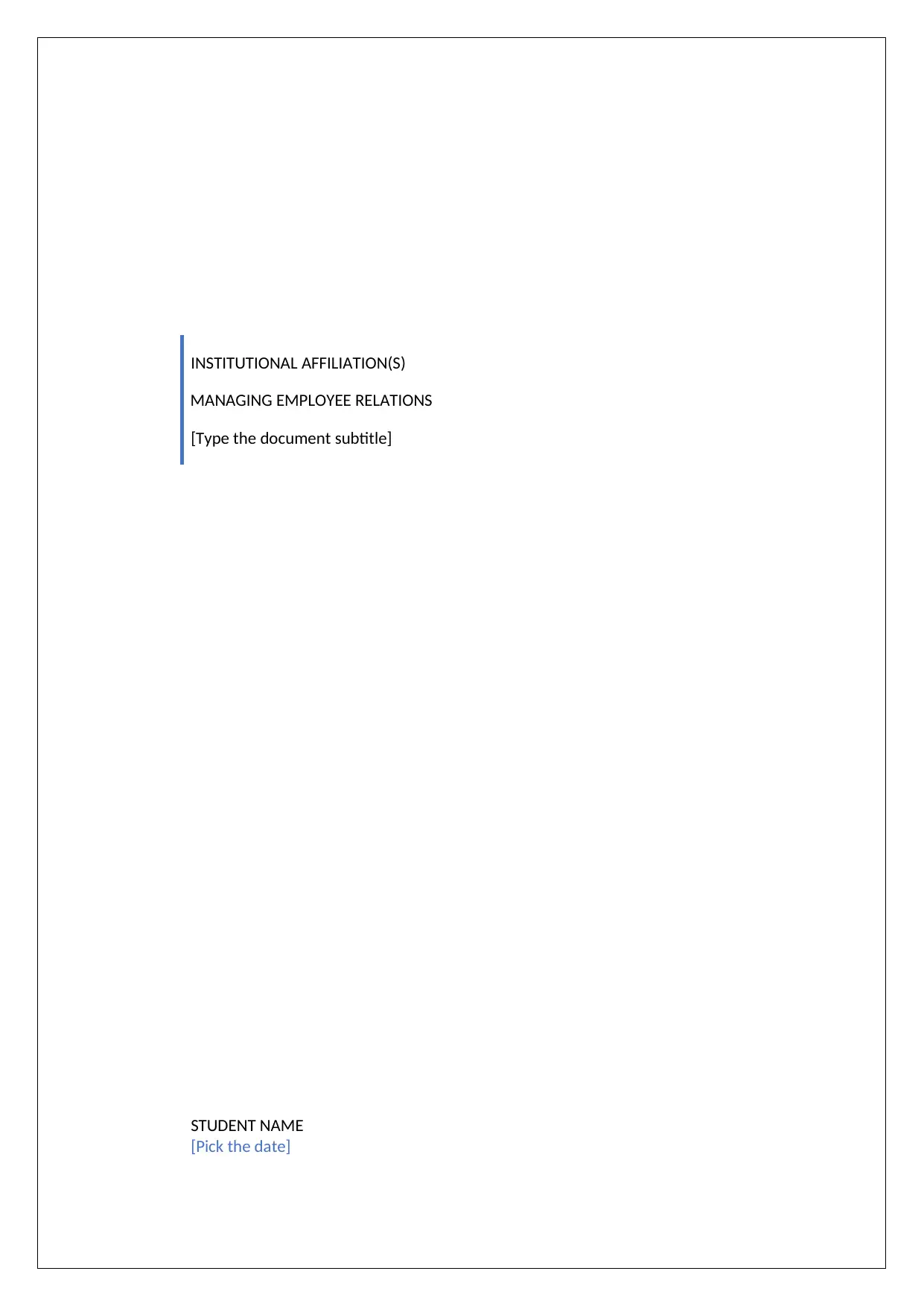
INSTITUTIONAL AFFILIATION(S)
MANAGING EMPLOYEE RELATIONS
[Type the document subtitle]
STUDENT NAME
[Pick the date]
MANAGING EMPLOYEE RELATIONS
[Type the document subtitle]
STUDENT NAME
[Pick the date]
Paraphrase This Document
Need a fresh take? Get an instant paraphrase of this document with our AI Paraphraser
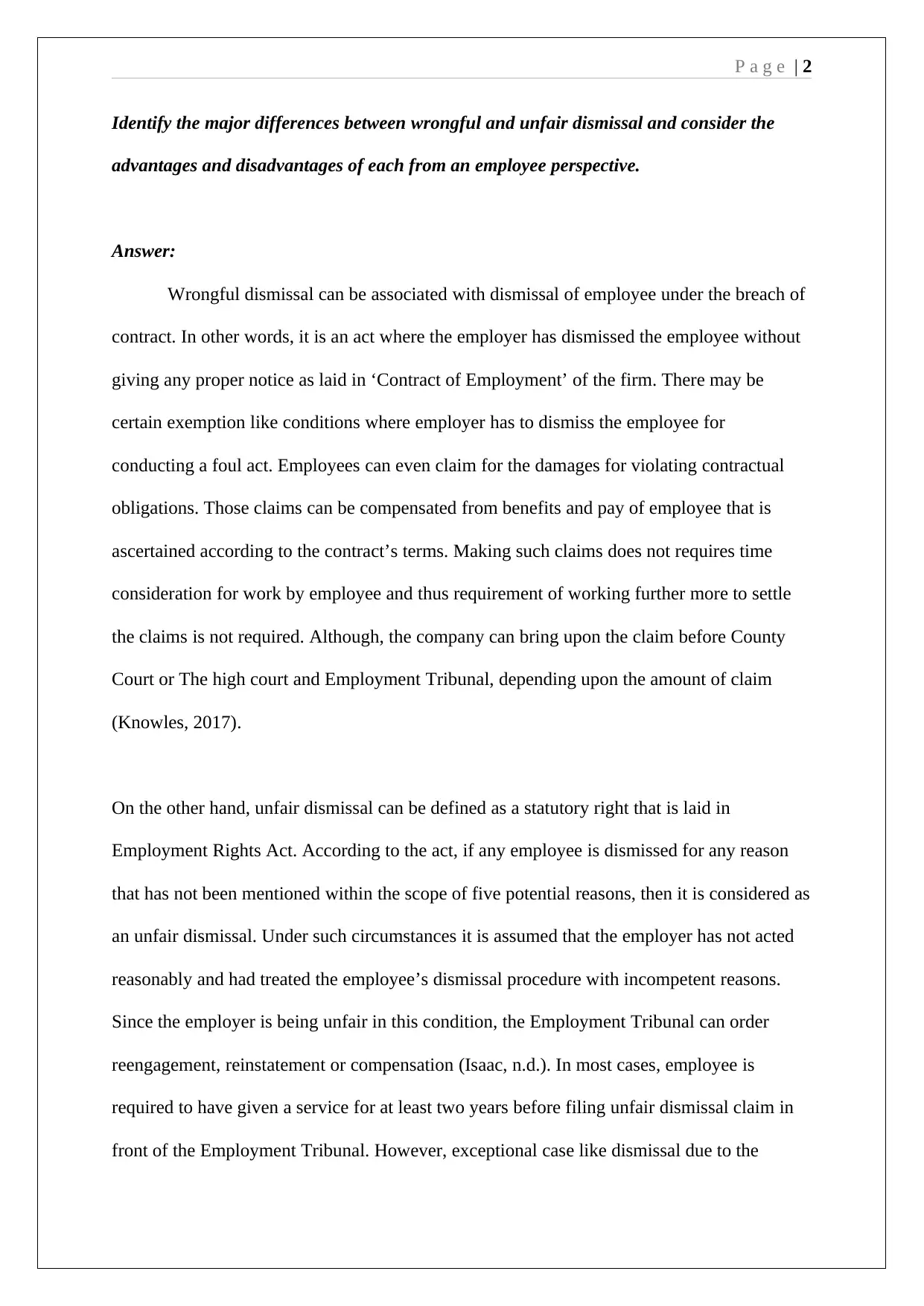
P a g e | 2
Identify the major differences between wrongful and unfair dismissal and consider the
advantages and disadvantages of each from an employee perspective.
Answer:
Wrongful dismissal can be associated with dismissal of employee under the breach of
contract. In other words, it is an act where the employer has dismissed the employee without
giving any proper notice as laid in ‘Contract of Employment’ of the firm. There may be
certain exemption like conditions where employer has to dismiss the employee for
conducting a foul act. Employees can even claim for the damages for violating contractual
obligations. Those claims can be compensated from benefits and pay of employee that is
ascertained according to the contract’s terms. Making such claims does not requires time
consideration for work by employee and thus requirement of working further more to settle
the claims is not required. Although, the company can bring upon the claim before County
Court or The high court and Employment Tribunal, depending upon the amount of claim
(Knowles, 2017).
On the other hand, unfair dismissal can be defined as a statutory right that is laid in
Employment Rights Act. According to the act, if any employee is dismissed for any reason
that has not been mentioned within the scope of five potential reasons, then it is considered as
an unfair dismissal. Under such circumstances it is assumed that the employer has not acted
reasonably and had treated the employee’s dismissal procedure with incompetent reasons.
Since the employer is being unfair in this condition, the Employment Tribunal can order
reengagement, reinstatement or compensation (Isaac, n.d.). In most cases, employee is
required to have given a service for at least two years before filing unfair dismissal claim in
front of the Employment Tribunal. However, exceptional case like dismissal due to the
Identify the major differences between wrongful and unfair dismissal and consider the
advantages and disadvantages of each from an employee perspective.
Answer:
Wrongful dismissal can be associated with dismissal of employee under the breach of
contract. In other words, it is an act where the employer has dismissed the employee without
giving any proper notice as laid in ‘Contract of Employment’ of the firm. There may be
certain exemption like conditions where employer has to dismiss the employee for
conducting a foul act. Employees can even claim for the damages for violating contractual
obligations. Those claims can be compensated from benefits and pay of employee that is
ascertained according to the contract’s terms. Making such claims does not requires time
consideration for work by employee and thus requirement of working further more to settle
the claims is not required. Although, the company can bring upon the claim before County
Court or The high court and Employment Tribunal, depending upon the amount of claim
(Knowles, 2017).
On the other hand, unfair dismissal can be defined as a statutory right that is laid in
Employment Rights Act. According to the act, if any employee is dismissed for any reason
that has not been mentioned within the scope of five potential reasons, then it is considered as
an unfair dismissal. Under such circumstances it is assumed that the employer has not acted
reasonably and had treated the employee’s dismissal procedure with incompetent reasons.
Since the employer is being unfair in this condition, the Employment Tribunal can order
reengagement, reinstatement or compensation (Isaac, n.d.). In most cases, employee is
required to have given a service for at least two years before filing unfair dismissal claim in
front of the Employment Tribunal. However, exceptional case like dismissal due to the
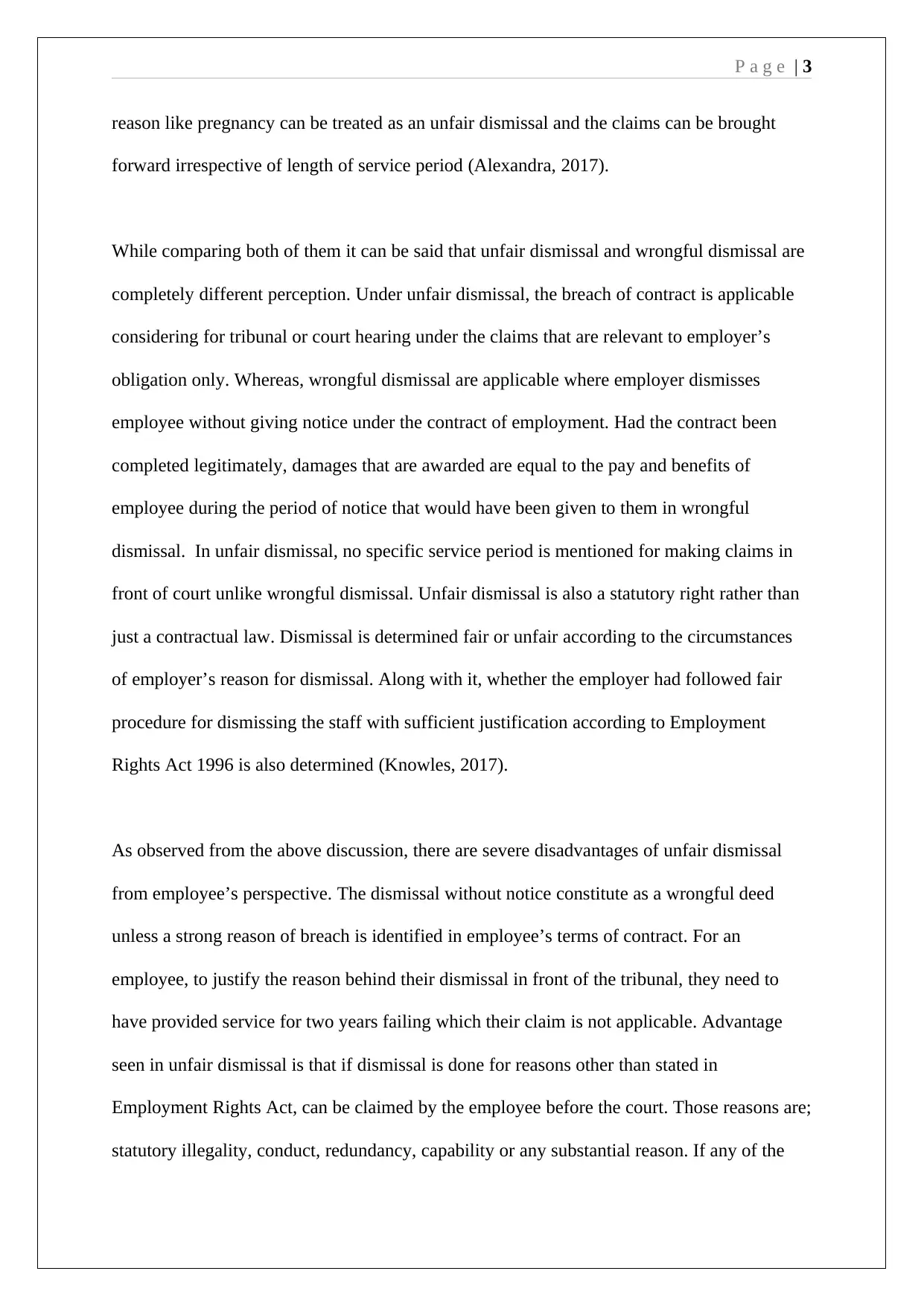
P a g e | 3
reason like pregnancy can be treated as an unfair dismissal and the claims can be brought
forward irrespective of length of service period (Alexandra, 2017).
While comparing both of them it can be said that unfair dismissal and wrongful dismissal are
completely different perception. Under unfair dismissal, the breach of contract is applicable
considering for tribunal or court hearing under the claims that are relevant to employer’s
obligation only. Whereas, wrongful dismissal are applicable where employer dismisses
employee without giving notice under the contract of employment. Had the contract been
completed legitimately, damages that are awarded are equal to the pay and benefits of
employee during the period of notice that would have been given to them in wrongful
dismissal. In unfair dismissal, no specific service period is mentioned for making claims in
front of court unlike wrongful dismissal. Unfair dismissal is also a statutory right rather than
just a contractual law. Dismissal is determined fair or unfair according to the circumstances
of employer’s reason for dismissal. Along with it, whether the employer had followed fair
procedure for dismissing the staff with sufficient justification according to Employment
Rights Act 1996 is also determined (Knowles, 2017).
As observed from the above discussion, there are severe disadvantages of unfair dismissal
from employee’s perspective. The dismissal without notice constitute as a wrongful deed
unless a strong reason of breach is identified in employee’s terms of contract. For an
employee, to justify the reason behind their dismissal in front of the tribunal, they need to
have provided service for two years failing which their claim is not applicable. Advantage
seen in unfair dismissal is that if dismissal is done for reasons other than stated in
Employment Rights Act, can be claimed by the employee before the court. Those reasons are;
statutory illegality, conduct, redundancy, capability or any substantial reason. If any of the
reason like pregnancy can be treated as an unfair dismissal and the claims can be brought
forward irrespective of length of service period (Alexandra, 2017).
While comparing both of them it can be said that unfair dismissal and wrongful dismissal are
completely different perception. Under unfair dismissal, the breach of contract is applicable
considering for tribunal or court hearing under the claims that are relevant to employer’s
obligation only. Whereas, wrongful dismissal are applicable where employer dismisses
employee without giving notice under the contract of employment. Had the contract been
completed legitimately, damages that are awarded are equal to the pay and benefits of
employee during the period of notice that would have been given to them in wrongful
dismissal. In unfair dismissal, no specific service period is mentioned for making claims in
front of court unlike wrongful dismissal. Unfair dismissal is also a statutory right rather than
just a contractual law. Dismissal is determined fair or unfair according to the circumstances
of employer’s reason for dismissal. Along with it, whether the employer had followed fair
procedure for dismissing the staff with sufficient justification according to Employment
Rights Act 1996 is also determined (Knowles, 2017).
As observed from the above discussion, there are severe disadvantages of unfair dismissal
from employee’s perspective. The dismissal without notice constitute as a wrongful deed
unless a strong reason of breach is identified in employee’s terms of contract. For an
employee, to justify the reason behind their dismissal in front of the tribunal, they need to
have provided service for two years failing which their claim is not applicable. Advantage
seen in unfair dismissal is that if dismissal is done for reasons other than stated in
Employment Rights Act, can be claimed by the employee before the court. Those reasons are;
statutory illegality, conduct, redundancy, capability or any substantial reason. If any of the
⊘ This is a preview!⊘
Do you want full access?
Subscribe today to unlock all pages.

Trusted by 1+ million students worldwide
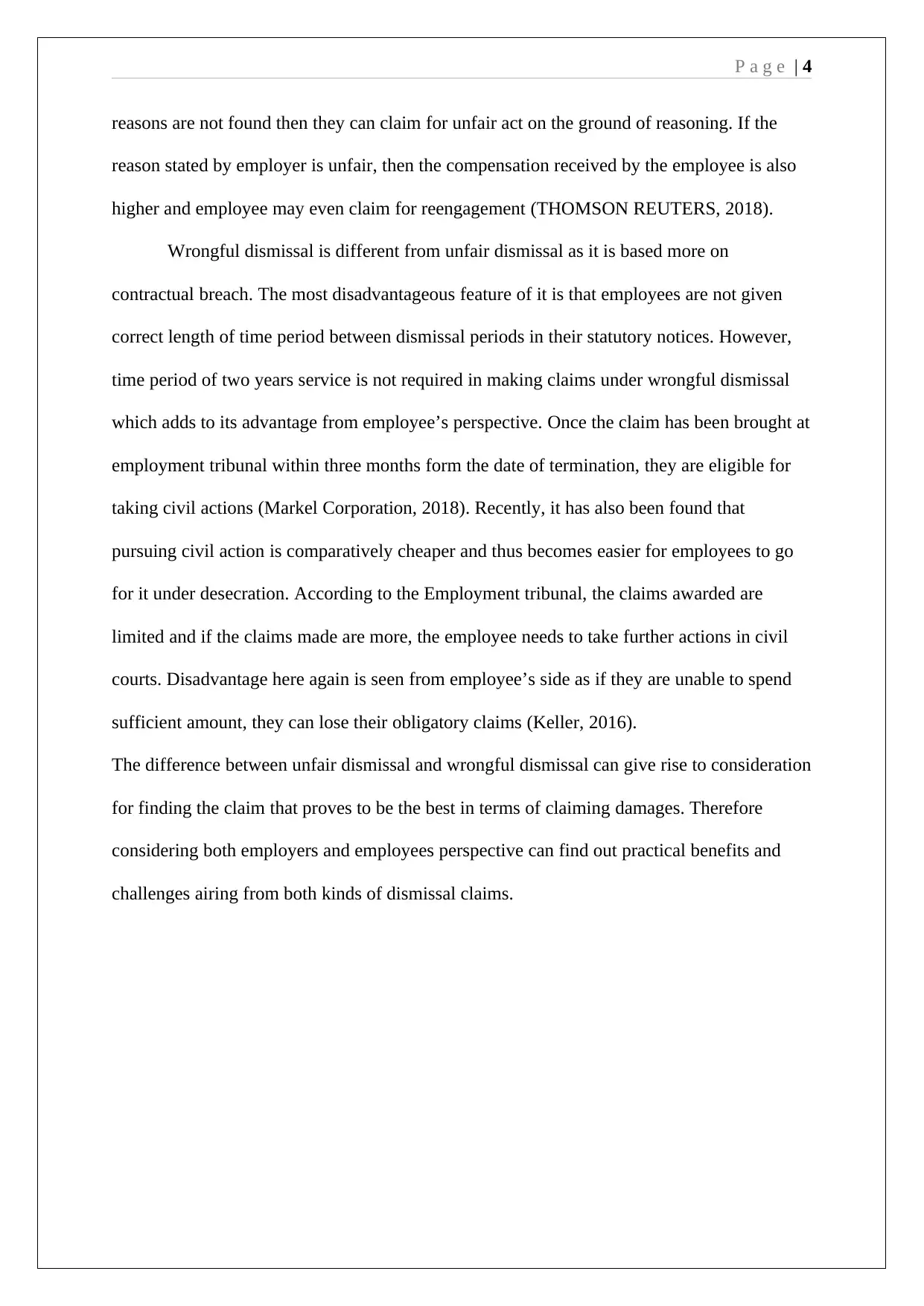
P a g e | 4
reasons are not found then they can claim for unfair act on the ground of reasoning. If the
reason stated by employer is unfair, then the compensation received by the employee is also
higher and employee may even claim for reengagement (THOMSON REUTERS, 2018).
Wrongful dismissal is different from unfair dismissal as it is based more on
contractual breach. The most disadvantageous feature of it is that employees are not given
correct length of time period between dismissal periods in their statutory notices. However,
time period of two years service is not required in making claims under wrongful dismissal
which adds to its advantage from employee’s perspective. Once the claim has been brought at
employment tribunal within three months form the date of termination, they are eligible for
taking civil actions (Markel Corporation, 2018). Recently, it has also been found that
pursuing civil action is comparatively cheaper and thus becomes easier for employees to go
for it under desecration. According to the Employment tribunal, the claims awarded are
limited and if the claims made are more, the employee needs to take further actions in civil
courts. Disadvantage here again is seen from employee’s side as if they are unable to spend
sufficient amount, they can lose their obligatory claims (Keller, 2016).
The difference between unfair dismissal and wrongful dismissal can give rise to consideration
for finding the claim that proves to be the best in terms of claiming damages. Therefore
considering both employers and employees perspective can find out practical benefits and
challenges airing from both kinds of dismissal claims.
reasons are not found then they can claim for unfair act on the ground of reasoning. If the
reason stated by employer is unfair, then the compensation received by the employee is also
higher and employee may even claim for reengagement (THOMSON REUTERS, 2018).
Wrongful dismissal is different from unfair dismissal as it is based more on
contractual breach. The most disadvantageous feature of it is that employees are not given
correct length of time period between dismissal periods in their statutory notices. However,
time period of two years service is not required in making claims under wrongful dismissal
which adds to its advantage from employee’s perspective. Once the claim has been brought at
employment tribunal within three months form the date of termination, they are eligible for
taking civil actions (Markel Corporation, 2018). Recently, it has also been found that
pursuing civil action is comparatively cheaper and thus becomes easier for employees to go
for it under desecration. According to the Employment tribunal, the claims awarded are
limited and if the claims made are more, the employee needs to take further actions in civil
courts. Disadvantage here again is seen from employee’s side as if they are unable to spend
sufficient amount, they can lose their obligatory claims (Keller, 2016).
The difference between unfair dismissal and wrongful dismissal can give rise to consideration
for finding the claim that proves to be the best in terms of claiming damages. Therefore
considering both employers and employees perspective can find out practical benefits and
challenges airing from both kinds of dismissal claims.
Paraphrase This Document
Need a fresh take? Get an instant paraphrase of this document with our AI Paraphraser
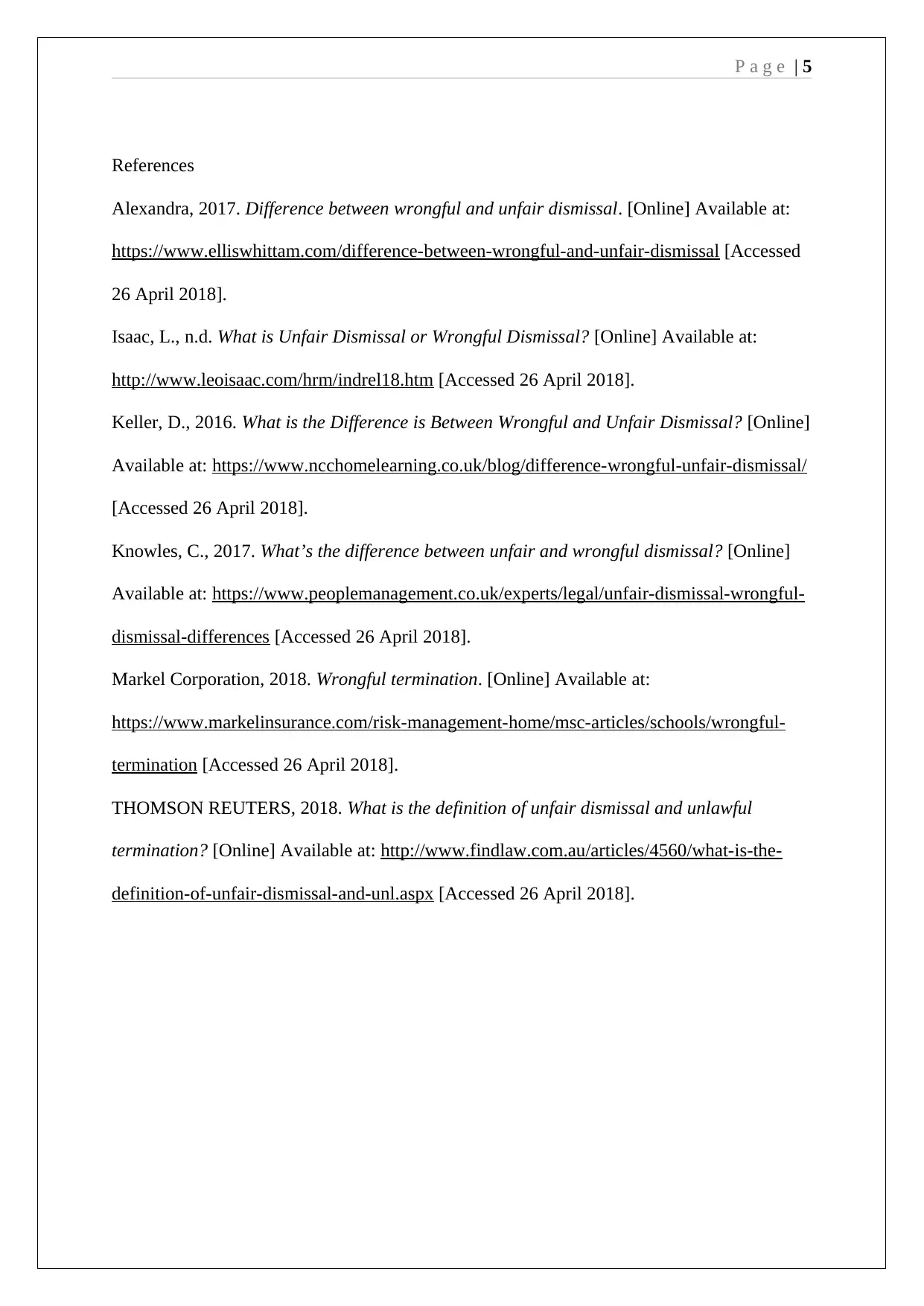
P a g e | 5
References
Alexandra, 2017. Difference between wrongful and unfair dismissal. [Online] Available at:
https://www.elliswhittam.com/difference-between-wrongful-and-unfair-dismissal [Accessed
26 April 2018].
Isaac, L., n.d. What is Unfair Dismissal or Wrongful Dismissal? [Online] Available at:
http://www.leoisaac.com/hrm/indrel18.htm [Accessed 26 April 2018].
Keller, D., 2016. What is the Difference is Between Wrongful and Unfair Dismissal? [Online]
Available at: https://www.ncchomelearning.co.uk/blog/difference-wrongful-unfair-dismissal/
[Accessed 26 April 2018].
Knowles, C., 2017. What’s the difference between unfair and wrongful dismissal? [Online]
Available at: https://www.peoplemanagement.co.uk/experts/legal/unfair-dismissal-wrongful-
dismissal-differences [Accessed 26 April 2018].
Markel Corporation, 2018. Wrongful termination. [Online] Available at:
https://www.markelinsurance.com/risk-management-home/msc-articles/schools/wrongful-
termination [Accessed 26 April 2018].
THOMSON REUTERS, 2018. What is the definition of unfair dismissal and unlawful
termination? [Online] Available at: http://www.findlaw.com.au/articles/4560/what-is-the-
definition-of-unfair-dismissal-and-unl.aspx [Accessed 26 April 2018].
References
Alexandra, 2017. Difference between wrongful and unfair dismissal. [Online] Available at:
https://www.elliswhittam.com/difference-between-wrongful-and-unfair-dismissal [Accessed
26 April 2018].
Isaac, L., n.d. What is Unfair Dismissal or Wrongful Dismissal? [Online] Available at:
http://www.leoisaac.com/hrm/indrel18.htm [Accessed 26 April 2018].
Keller, D., 2016. What is the Difference is Between Wrongful and Unfair Dismissal? [Online]
Available at: https://www.ncchomelearning.co.uk/blog/difference-wrongful-unfair-dismissal/
[Accessed 26 April 2018].
Knowles, C., 2017. What’s the difference between unfair and wrongful dismissal? [Online]
Available at: https://www.peoplemanagement.co.uk/experts/legal/unfair-dismissal-wrongful-
dismissal-differences [Accessed 26 April 2018].
Markel Corporation, 2018. Wrongful termination. [Online] Available at:
https://www.markelinsurance.com/risk-management-home/msc-articles/schools/wrongful-
termination [Accessed 26 April 2018].
THOMSON REUTERS, 2018. What is the definition of unfair dismissal and unlawful
termination? [Online] Available at: http://www.findlaw.com.au/articles/4560/what-is-the-
definition-of-unfair-dismissal-and-unl.aspx [Accessed 26 April 2018].
1 out of 5
Related Documents
Your All-in-One AI-Powered Toolkit for Academic Success.
+13062052269
info@desklib.com
Available 24*7 on WhatsApp / Email
![[object Object]](/_next/static/media/star-bottom.7253800d.svg)
Unlock your academic potential
Copyright © 2020–2025 A2Z Services. All Rights Reserved. Developed and managed by ZUCOL.





